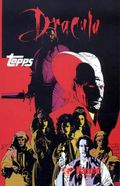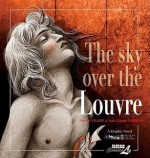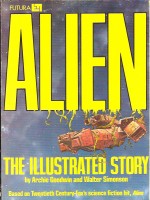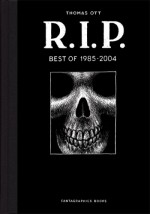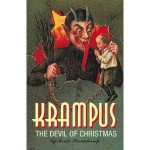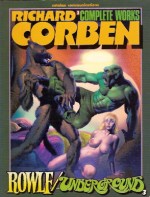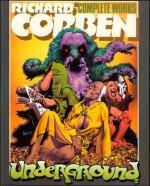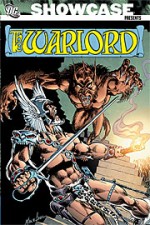
By Mike Grell, with Vince Colletta & various (DC Comics)
ISBN13: 978-1-4012-2473-8
During the troubled 1970s the American comics industry suffered one of the worst of its periodic downturns and publishers desperately cast about for other genres to bolster the flagging sales of superhero comics.
By revising their self-imposed industry code of practice (administered by the Comics Code Authority) to allow supernatural and horror comics, the publishers tapped into the global revival of interest in spiritualism and the supernatural, and as a by-product opened their doors to Sword-and-Sorcery as a viable genre, with Roy Thomas and Barry Smith’s adaptation of R. E. Howard’s Conan the Barbarian an early exemplar.
DC launched a host of titles into that budding market but although individually interesting nothing seemed to catch the public’s eye until number #8 of the company’s latest try-out title First Issue Special.
In that issue popular new Legion of Super-Heroes artist Mike Grell launched his pastiche, homage and tribute to Edgar Rice Burroughs’s works (particularly Pellucidar – At the Earth’s Core) which, after a rather shaky start (like Conan, the series was cancelled early in the run but rapidly reinstated) went on to become for a time DC’s most popular title.
Blending swords, sorcery and super-science with spectacular, visceral derring-do, the lost land of Skartaris was a venue expertly designed for adventure: stuffed with warriors, mythical creatures, dinosaurs and scantily-clad hotties. How could it possibly fail?
This first stupendous black and white compendium, gathers 1st Issue Special #8 (from November 1975) and Warlord #1-28 (January-February 1976 – December 1979) and delivers wild wonder and breathtaking thrills from the outset.
The magic commences with ‘Land of Fear!’ as in 1969, U2 spy-pilot Colonel Travis Morgan is shot down whilst filming a secret Soviet base. The embattled aviator manages to fly his plane over the North Pole before ditching, expecting to land on frozen Tundra or pack-ice the right side of the Iron Curtain.
Instead he finds himself inside the Earth, marooned in a vast, tropical jungle where the sun never sets. The incredible land is populated by creatures from every era of history and many that never made it into the science books. There are also cavemen, savages, lost races, mythical beasts, barbaric kingdoms and fabulous warrior-women.
Plunging head-on into the madness the baffled airman saves an embattled princess from a hungry saurian before both are captured by soldiers. Taken to the city of Thera, Morgan is taught the language by his fellow captive Tara and makes an implacable enemy of the court wizard Deimos. After surviving an assassination attempt the pair escape into the eternal noon of the land beneath the Earth.
Within months Morgan had his own-bimonthly title written, pencilled and inked by Grell. ‘This Savage World’ saw the lost airman and the Princess of Shamballah fall deeply in love, only to be separated by slavers who leave Morgan to die in #2’s ‘Arena of Death.’ After a stint as a galley slave, Morgan, with Nubian warrior Machiste, led an insurrection of Gladiators which became a full-scale revolution, earning him the title of The Warlord in the process.
However, after this issue the series vanished for months until October-November 1976.
Morgan returned in all his gory glory in #3’s ‘War Gods of Skartaris’, leading his army of liberation and hunting for Tara until he stumbled across his downed aircraft – worshipped as a god by lizard-men and stuffed with lots of twentieth century ordnance… Moreover it had crashed into a temple that gave the first clues to the incredible secret of the lost land…
‘Duel of the Titans’ saw the Warlord’s army lay siege to Thera, where Deimos had seized power and held Tara hostage. The mage’s sorcery was no match for high explosives and inevitably he lost his life to Morgan’s flashing blade.
Warlord #5 saw the reunited lovers heading for Tara’s home city Shamballah, discovering en route ‘The Secret of Skartaris!’ in a lost temple that held millennia-old computer records revealing the entire land to be a lost colony of Atlantis, with much of the magic of the timeless region nothing more than advanced technology. When one such dormant device rocketed Morgan away Tara thought her man was gone forever…
‘Home is a Four-Letter Word!’ saw the displaced aviator returned to the surface-world with eight years gone by since his crash; emerging from a lost outpost in the Andes where a multi-national excavation was being conducted in the Incan ruins of Machu Pichu.
However the scientists used Morgan’s dog-tags to contact his CIA superiors and the suspicious spooks assumed he had defected all these years ago: especially since one of the archaeologists was comely soviet researcher Mariah Romanova… When the intransigent spymasters roused a demonic watchdog Morgan’s only chance was to head back to Skartaris with Mariah in tow…
Back in the temple again, the day he spent on Earth had somehow translated into an interminable time within it. Tara was long gone and Morgan elected to follow her to Shamballah. Stopping in the city of Kiro Morgan and Mariah saved the Warlord’s old comrade Machiste from the insidious horror of ‘The Iron Devil’, after which the trio voyaged together: attacked by cyborg vampires from ‘The City in the Sky’ and braving ‘The Lair of the Snowbeast’, wherein Morgan discovered a unique benefactor and a tragically brief kind of love…
Warlord #10 saw the opening sally in a long-running saga as the ‘Tower of Fear’ found the trio aiding a maiden in distress and inadvertently restoring the underland’s greatest monster to life. ‘Trilogy’ in #11 features a triptych of vignettes to display conflicting aspects of the Warlord’s complex character, after which ‘The Hunter’ pitted the wandering warriors against a manic, vengeful CIA agent who had followed Morgan to Skartaris and ‘All Men Are Mine’ saw the gravely wounded Warlord battle the very personification of death.
Issue #15 ‘Holocaust’ (inked by Joe Rubinstein) marked the series’ advancement to a monthly schedule and finally reunited Morgan and Tara in Shamballah. The obtuse warrior was stunned to see Mariah heartbroken by the couple’s joy, resulting in hers and Machiste’s incensed departure. The biggest shock, though, was Morgan’s introduction to his son, Joshua. However he didn’t have much time to dwell as the city began to explosively self-destruct. As Morgan and Tara tackled the major crisis Deimos struck, abducting the baby…
Vince Colletta came aboard as regular inker with the beginning of ‘The Quest’ as Morgan and Tara hunted down the undead sorcerer starting with ‘Visions in a Crimson Eye’, battling Deimos’ minions and rival magicians, encountering the desert-locked ‘Citadel of Death’ (which revealed some intriguing Skartaran history from the Age of the Wizard Kings) before being briefly distracted by alien invaders in ‘Bloodmoon’.
Scouring Skartaris, Tara and Morgan were reunited with Mariah and Machiste in ‘Wolves of the Steppes’ after which the quartet braved Deimos’ fortress in ‘Battlecry’ as the unliving savant began experimenting on little Joshua, marrying Atlantean science with sinister sorceries…
The epic concluded in Warlord #21 as Morgan was compelled to battle an adult enslaved version of Joshua in ‘Terminator’. When he killed his own son, the Warlord’s heart broke and his love abandoned him… but as ever nothing was as it quite seemed…
Shell-shocked, Morgan lost himself in drink and bloodletting, battling werewolves and worse in ‘The Beast in the Tower’, subterraneans and cannibals in ‘The Children of Ba’al’ and tragically trysting with a love that could not last in ‘Song of Ligia’ before becoming a mercenary in ‘This Sword For Hire’, making a new friend in unscrupulous but flamboyant thief Ashir.
Together they accept ‘The Challenge’ of winning ultimate knowledge and as Deimos begins his next deadly assault Morgan relives all his past lives (which include Lancelot, Jim Bowie and Crazy Horse) whilst experiencing first hand the true story of ‘Atlantis Dying’…
The last issue in this compilation comprises two linked tales. In the first Morgan crushes alien horrors in ‘The Curse of the Cobra Queen’ whilst the long absent Tara, Mariah and Machiste are drawn into a time-warping encounter with the lost masters of ‘Wizard World’ – the opening salvo in another extended epic that you’ll have to wait for the second volume to enjoy…
The tricky concept of relativistic time and how it does or doesn’t seem to function in this Savage Paradise increasingly grated with many readers but as Grell’s stated goal was to produce a perfect environment for yarn-spinning, not a science project, the picky pedant would be best advised to suck it up or stay away.
For we simple, thrill-seeking fantasy lovers, however, these are pure escapist tales of action and adventure, light on plot and angst but aggressively and enthusiastically jam-packed with fun and wonder. These are timeless tales that will enthral, beguile and enchant. As the man himself constantly says “in Skartaris, always expect the unexpectedâ€â€¦
© 1975, 1976, 1977, 1978, 1979, 2009 DC Comics. All Rights Reserved.


